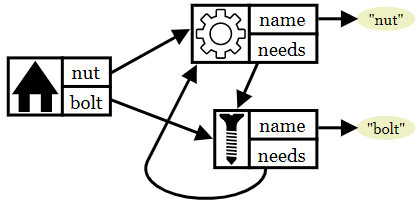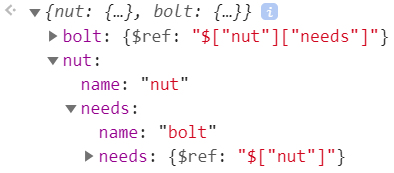Serializing object that contains cyclic object value
This is kind of an alternate-answer, but since what a lot of people will come here for is debugging their circular objects and there's not really a great way to do that without pulling in a bunch of code, here goes.
One feature that's not as well-known as JSON.stringify() is console.table(). Simply call console.table(whatever);, and it will log the variable in the console in tabular format, making it rather quite easy and convenient to peruse the variable's contents.
Use the second parameter of stringify, the replacer function, to exclude already serialized objects:
var seen = [];
JSON.stringify(obj, function(key, val) {
if (val != null && typeof val == "object") {
if (seen.indexOf(val) >= 0) {
return;
}
seen.push(val);
}
return val;
});
http://jsfiddle.net/mH6cJ/38/
As correctly pointed out in other comments, this code removes every "seen" object, not only "recursive" ones.
For example, for:
a = {x:1};
obj = [a, a];
the result will be incorrect. If your structure is like this, you might want to use Crockford's decycle or this (simpler) function which just replaces recursive references with nulls:
function decycle(obj, stack = []) {
if (!obj || typeof obj !== 'object')
return obj;
if (stack.includes(obj))
return null;
let s = stack.concat([obj]);
return Array.isArray(obj)
? obj.map(x => decycle(x, s))
: Object.fromEntries(
Object.entries(obj)
.map(([k, v]) => [k, decycle(v, s)]));
}
//
let a = {b: [1, 2, 3]}
a.b.push(a);
console.log(JSON.stringify(decycle(a)))Here is an example of a data structure with cyclic references:

function makeToolshed(){
var nut = {name: 'nut'}, bolt = {name: 'bolt'};
nut.needs = bolt; bolt.needs = nut;
return { nut: nut, bolt: bolt };
}
When you wish to KEEP the cyclic references (restore them when you deserialize, instead of "nuking" them), you have 2 choices, which I'll compare here. First is Douglas Crockford's cycle.js, second is my siberia package. Both work by first "decycling" the object, i.e., constructing another object (without any cyclic references) "containing the same information."
Mr. Crockford goes first:
JSON.decycle(makeToolshed())

As you see, the nested structure of JSON is retained, but there is a new thing, which is objects with the special $ref property. Let's see how that works.
root = makeToolshed();
[root.bolt === root.nut.needs, root.nut.needs.needs === root.nut]; // retutrns [true,true]
The dollar sign stands for the root. .bolt having $ref tells us that .bolt is an "already seen" object, and the value of that special property (here, the string $["nut"]["needs"]) tells us where, see first === above. Likewise for second $ref and the second === above.
Let's use a suitable deep equality test (namely Anders Kaseorg's deepGraphEqual function from accepted answer to this question) to see if cloning works.
root = makeToolshed();
clone = JSON.retrocycle(JSON.decycle(root));
deepGraphEqual(root, clone) // true
serialized = JSON.stringify(JSON.decycle(root));
clone2 = JSON.retrocycle(JSON.parse(serialized));
deepGraphEqual(root, clone2); // true
Now, siberia:
JSON.Siberia.forestify(makeToolshed())

Siberia does not try to mimic "classic" JSON, no nested structure. The object graph is described in a "flat" manner.
Each node of the object graph is turned into a flat tree (plain key value pair list with integer-only values), which is an entry in .forest. At index zero, we find the root object, at higher indices, we find the other nodes of the object graph, and negative values (of some key of some tree of the forest) point to the atoms array, (which is typed via the types array, but we'll skip the typing details here). All terminal nodes are in the atoms table, all non-terminal nodes are in the forest table, and you can see right away how many nodes the object graph has, namely forest.length. Let's test if it works:
root = makeToolshed();
clone = JSON.Siberia.unforestify(JSON.Siberia.forestify(root));
deepGraphEqual(root, clone); // true
serialized = JSON.Siberia.stringify(JSON.Siberia.forestify(root));
clone2 = JSON.Siberia.unforestify(JSON.Siberia.unstringify(serialized));
deepGraphEqual(root, clone2); // true
comparison
will add section later.
note
I'm currently refactoring the package. Central ideas and algorithms are staying the same, but the new version will be easier to use, the top level API will be different. I will very soon archive siberia and present the refactored version, which I'll call objectgraph. Stay tuned, it will happen this month (August 2020)
ah, and ultra short version for the comparison. For a "pointer", I need as much space as an integer takes, since my "pointers to already seen nodes" (as a matter of fact, to all nodes, already seen or not) are just integers. In Mr. Crockford's version, amount needed to store a "pointer" is bounded only by the size of the object graph. That makes the worst case complexity of Mr. Crockford's version extremely horrible. Mr. Crockford gave us "another Bubblesort". I'm not kidding you. It's that bad. If you don't believe it, there are tests, you can find them starting from the readme of the package (will transform them to be benchmark.js compliant also this month, Aug 2020)